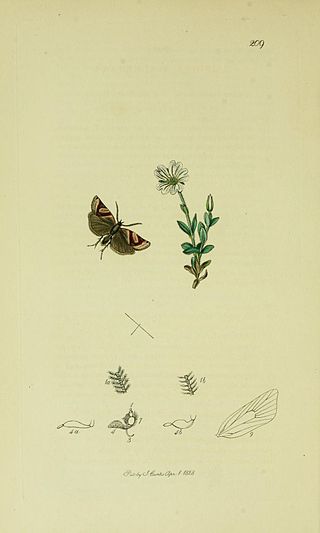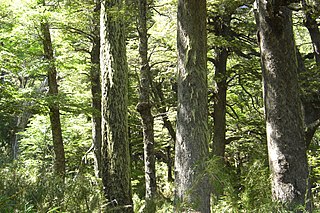
Tierra del Fuego is an archipelago off the southernmost tip of the South American mainland, across the Strait of Magellan.

Cirsium is a genus of perennial and biennial flowering plants in the Asteraceae, one of several genera known commonly as thistles. They are more precisely known as plume thistles. These differ from other thistle genera in having a seed with a pappus of feathered hairs on their achenes. The other genera have a pappus of simple unbranched hairs.

The tree line is the edge of a habitat at which trees are capable of growing and beyond which they are not. It is found at high elevations and high latitudes. Beyond the tree line, trees cannot tolerate the environmental conditions. The tree line is sometimes distinguished from a lower timberline, which is the line below which trees form a forest with a closed canopy.

Pinus contorta, with the common names lodgepole pine and shore pine, and also known as twisted pine, and contorta pine, is a common tree in western North America. It is common near the ocean shore and in dry montane forests to the subalpine, but is rare in lowland rain forests. Like all pines, it is an evergreen conifer.

The Magellanic subpolar forests are a terrestrial ecoregion of southernmost South America, covering parts of southern Chile and Argentina, and are part of the Neotropical realm. It is a temperate broadleaf and mixed forests ecoregion, and contains the world's southernmost forests.

Cirsium vulgare, the spear thistle, bull thistle, or common thistle, is a species of the Asteraceae genus Cirsium, native throughout most of Europe, Western Asia, and northwestern Africa. It is also naturalised in North America, Africa, and Australia and is an invasive weed in several regions. It is the national flower of Scotland.

Cirsium palustre, the marsh thistle or European swamp thistle, is a herbaceous biennial flowering plant in the family Asteraceae.

Isla Grande de Tierra del Fuego also formerly Isla de Xátiva is an island near the southern tip of South America from which it is separated by the Strait of Magellan. The western portion (61.4%) of the island is in Chile, while the eastern portion is in Argentina. It forms the major landmass in an extended group of islands or archipelago also known as Tierra del Fuego.

Nothofagus antarctica is a deciduous tree or shrub native to southern Chile and Argentina from about 36°S to Tierra del Fuego, where it grows mainly in the diminishing temperate rainforest.

Nothofagus betuloides, Magellan's beech or guindo, is a tree native to southern Patagonia.

Equisetum palustre, the marsh horsetail, is a perennial herbaceous pteridophyte belonging to the subclass of horsetails (Equisetidae). It is widespread in cooler regions of Eurasia and North America.
The Juncus subnodulosus–Cirsium palustre fen-meadow is a plant association characteristically found on damp ground in portions of western Europe. This type of fen-meadow appears to have co-evolved with human agriculture in Europe since the earlier Holocene.

Carex disticha is a Eurasian species of sedge known as the brown sedge or, in North America, tworank sedge.

Philedonides lunana, also known as the heath tortrix and Walker’s Lanark tortrix, is a moth of the family Tortricidae. It was first described by Carl Peter Thunberg in 1784 and is found in most of Europe.

Cirsium vinaceum is a rare species of thistle known by the common name Sacramento Mountains thistle. It is endemic to Otero County, New Mexico, in the United States, where it is known only from the Sacramento Mountains. The plant can be found in six canyon systems in a southern section of this mountain range spanning about 32 kilometers. It is rare because it is limited to a specific type of mountain wetland which is both naturally uncommon and threatened by a number of forces. The plant was federally listed as threatened in 1987.

Tierra del Fuego National Park is a national park on the Argentine part of the island of Tierra del Fuego, within Tierra del Fuego Province in the ecoregion of Patagonic Forest and Altos Andes, a part of the subantarctic forest. Established on 15 October 1960 under the Law 15.554 and expanded in 1966, it was the first shoreline national park to be established in Argentina.

Bosque Andino Patagónico, also known as Patagonian Andean forest, is a type of temperate to cold forest located in western Patagonia in Argentina and also in southern Chile, at the southern end of South America. The climate here is influenced by humid air masses moving in from the Pacific Ocean which lose most of their moisture as they rise over the Andes. The flora is dominated by trees, usually of the genus Nothofagus.

The Faroe Islands boreal grasslands ecoregion covers all of the territory of the Faroe Islands, an archipelago of 18 islands in the North Atlantic, roughly equidistant between Scotland, Norway, and Iceland. The ground cover is mostly grassland and dwarf shrub heath, the remainder is bare ground or sparse vegetation. There are no forests on the islands.



















